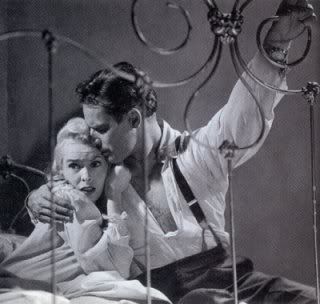
Because we had both seen this one before, we were able to watch it a little more critically than a first-time viewer. Taxi Driver is the story of an alienated young Vietnam vet driving a Checker Cab in New York City. When he is rejected by the girl he takes to a porno on their date, he goes off the deep end and vows to rid the streets of NYC of all the scum.
Emily: Apparently the screenwriter, Paul Schrader, based the character of Travis Bickle on himself. While living in Los Angeles, he had a nervous breakdown, became really depressed, didn't talk to anyone for weeks, and developed an obsession with guns. Just a little trivia courtesy of imdb.
Kamala: This movie was shopped around by Shrader to a lot of studios, and Columbia took it with the package deal of Scorcese and DeNiro. After seeing Mean Streets, the tale of an epileptic mobster, Harvey Keitel, and his crazy cousin, DeNiro, the studio execs really wanted another Scorcese and DeNiro collaboration. Thank god because the other options for Bickle, according to wikipedia, were like Neal Diamond and Jeff Bridges......
Emily: Travis' monologues describing NYC as an "open sewer," the scene with Martin Scorcese in the back of the cab talking about shooting his wife in the face with a 44 magnum, and every scene shot with Harvey Keitel as the gross child-raping pimp build on the themes of urban decay coupled with the loneliness and isolation of post-Vietnam America. Robert DeNiro's character wants to make his mark on the world, (spoiler alert!) even attempting to assassinate a New York senator-the irony of the ending is that this man is hailed as a vigilante hero when really he's just an unhinged killer. America's fascination with folk heroes never ceases to astonish me.
Kamala: Yeah like Mr. Turner told us this story today about some horned toad called Old Rip that was buried in a corner stone in some building, and years later, when the building was demolished, they found the toad and it was alive!!! They even took it to meet Calvin Coolidge. Bizarre.
Emily: How does that have anything to do with folk heroes?
Kamala: It's got to do with American mythologizing. It's because the toad was underneath a Bible that it survived and it was such a big deal.
Emily: I'm not sure Peter Boyle can be anything but Frankenstein's monster in any movie he has a role in. I look at him and it's all I see. He has a small role as a cabbie.
Kamala: Jodie Foster is great for the role of the baby prostitute because she looks really young but sounds old.
Emily: The movie is really all about Robert DeNiro and his jacked body doing clap push-ups. Rocky won out over this movie for Best Picture in 1976, but watch the scene with DeNiro doing clap push-ups and you will be just as inspired to be the best you can be!






/ElizabethTaylorCleopatra.jpg)








